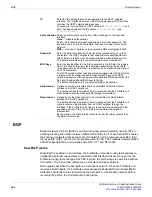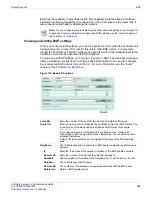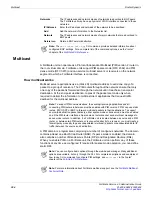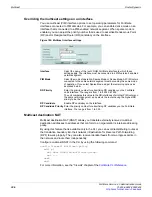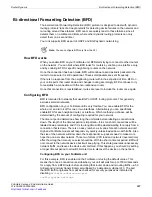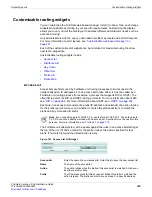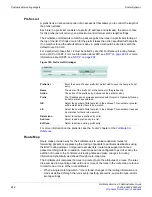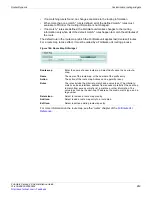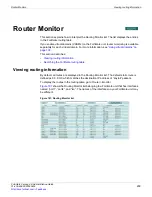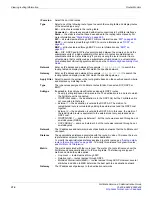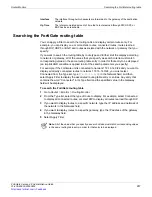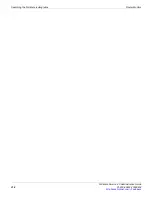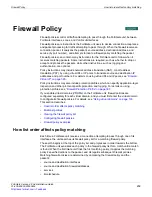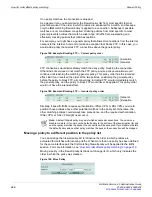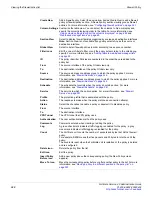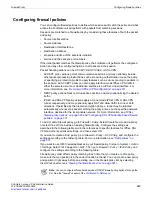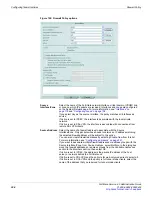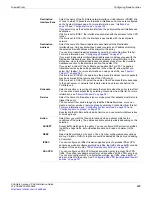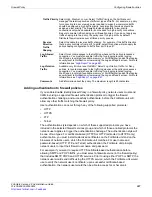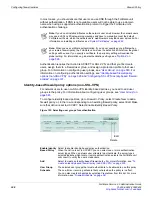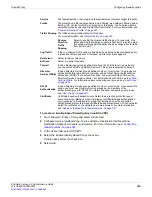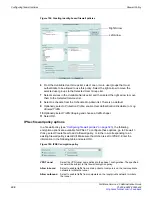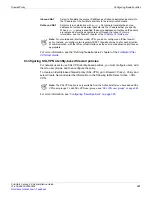
Viewing routing information
Router Monitor
FortiGate Version 4.0 Administration Guide
316
01-400-89802-20090424
IP version
Select IPv4 or IPv6 routes.
Type
Select one of the following route types to search the routing table and display routes
of the selected type only:
All
— all routes recorded in the routing table.
Connected
— all routes associated with direct connections to FortiGate interfaces.
Static
— the static routes that have been added to the routing table manually. For
more information see
RIP
— all routes learned through RIP. For more information see
.
OSPF
— all routes learned through OSPF. For more information see
BGP
— all routes learned through BGP. For more information see
HA
— RIP, OSPF, and BGP routes synchronized between the primary unit and the
subordinate units of a high availability (HA) cluster. HA routes are maintained on
subordinate units and are visible only if you are viewing the router monitor from a
virtual domain that is configured as a subordinate virtual domain in a virtual cluster.
For details about HA routing synchronization, see the
FortiGate High Availability User
.
Network
Enter an IP address and netmask (for example,
172.16.14.0/24
) to search the
routing table and display routes that match the specified network.
Gateway
Enter an IP address and netmask (for example,
192.168.12.1/32
) to search the
routing table and display routes that match the specified gateway.
Apply Filter
Select to search the entries in the routing table based on the specified search criteria
and display any matching routes.
Type
The type values assigned to FortiGate routes (Static, Connected, RIP, OSPF, or
BGP).
Subtype
If applicable, the subtype classification assigned to OSPF routes.
•
An empty string implies an intra-area route. The destination is in an area to which
the FortiGate unit is connected.
•
OSPF inter area
— the destination is in the OSPF AS, but the FortiGate unit is
not connected to that area.
•
External 1
— the destination is outside the OSPF AS. The metric of a
redistributed route is calculated by adding the external cost and the OSPF cost
together.
•
External 2
— the destination is outside the OSPF AS. In this case, the metric of
the redistributed route is equivalent to the external cost only, expressed as an
OSPF cost.
•
OSPF NSSA 1
— same as External 1, but the route was received through a not-
so-stubby area (NSSA).
•
OSPF NSSA 2
— same as External 2, but the route was received through a not-
so-stubby area.
Network
The IP addresses and network masks of destination networks that the FortiGate unit
can reach.
Distance
The administrative distance associated with the route. A value of 0 means the route
is preferable compared to routes to the same destination.
To modify the administrative distance assigned to static routes, see
route to the routing table” on page 284
. To modify this distance for dynamic routes,
see
Metric
The metric associated with the route type. The metric of a route influences how the
FortiGate unit dynamically adds it to the routing table. The following are types of
metrics and when they are applied.
•
Hop count
— routes learned through RIP.
•
Relative cost
— routes learned through OSPF.
•
Multi-Exit Discriminator (MED)
— routes learned through BGP. However, several
attributes in addition to MED determine the best path to a destination network.
Gateway
The IP addresses of gateways to the destination networks.
Содержание Gate 60D
Страница 678: ...Reports Log Report FortiGate Version 4 0 Administration Guide 678 01 400 89802 20090424 http docs fortinet com Feedback...
Страница 704: ...Index FortiGate Version 4 0 Administration Guide 704 01 400 89802 20090424 http docs fortinet com Feedback...
Страница 705: ...www fortinet com...
Страница 706: ...www fortinet com...

